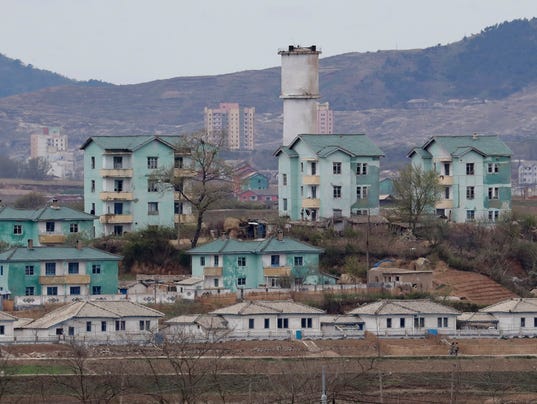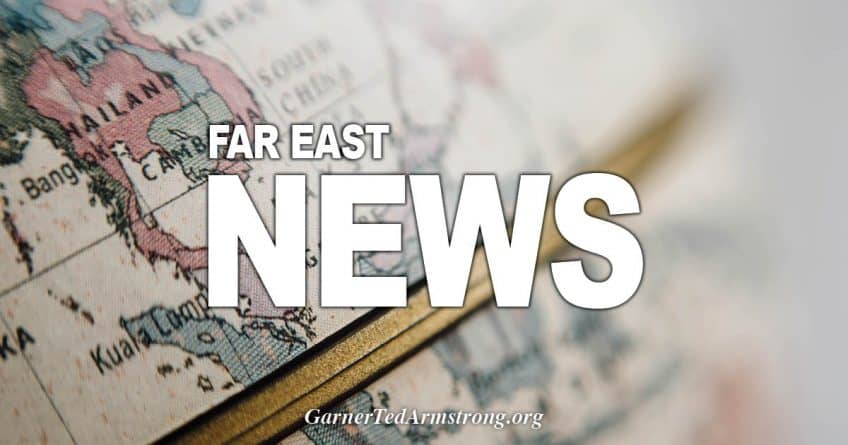
North Korean village of Gijungdong is seen during a press tour from the Taesungdong freedom village inside the demilitarized zone between North and South Korea in Paju, South Korea, on April 24, 2018.(Photo: Lee Jin-man, AP)
SEOUL — Friday’s summit between North Korean dictator Kim Jong Un and South Korean President Moon Jae-in will mark the third time the countries’ leaders have met since the Korean War ended in 1953.
The two previous summits were held in 2000 and 2007. In each case, hopes were high for a major breakthrough in relations on the Korean Peninsula. Each summit was considered a historic success at its time.
The 2000 meeting even earned South Korean President Kim Dae-jung the Nobel Peace Prize. But in both cases the good vibes wouldn’t last long, as North Korea secretly continued to develop its nuclear and missile programs despite agreements to stop.
This time, there is a different cast of characters, and the circumstances — including an unprecedented follow-up meeting of Kim and President Trump in May or June— might produce a more lasting outcome.
The earlier summits remain cautionary tales. In both cases, economic and humanitarian exchanges were given before a detailed framework for denuclearization was in place. Analysts warn Moon not to make the same mistake.
2000 Summit
The first inter-Korean summit was held in Pyongyang, the North Korean capital, in June 2000. South Korean President Kim Dae-jung met for three days with North Korean dictator Kim Jong-il, father of the North’s current leader.
During the lead-up to the summit, North Korea expanded its diplomatic engagement with the outside world, just as Kim Jong Un has done in recent months. Kim Jong-il met with Chinese leaders in Beijing before of the summit and would later welcome Russian President Vladimir Putin to Pyongyang.
Famine and extreme shortages of goods and fuel in the 1990s plagued North Korea — in part because of the collapse of the Soviet Union in 1991. This provided motivation for the North to engage with the international community.
Images of Kim Dae-jung and Kim Jong-il shaking hands and clinking champagne glasses filled the airwaves and enthralled many South Korean viewers, as the two leaders signed a broad agreement to work toward peace and reunification. Kim Jong-il called the date of the meeting, June 13, “a day that would be recorded in history.”
More: From nukes to U.S. troops: The 5 key obstacles to peace with North Korea
Kim Dae-jung later declared that ”the danger of war on the Korean Peninsula has disappeared.”
Kim Dae-jung would go on to win the Nobel Peace Prize in November that year for his “sunshine policy” of rapprochement with the North. Economic cooperation followed the meeting, along with rail and road links and the start of a family reunion program.
By the end of 2002, the international community found that North Korea secretly continued its missile and nuclear programs, in violation of a 1994 framework signed with the United States. In 2003, a scandal emerged that Kim Dae-jung’s administration had secretly — and illegally — transferred hundreds of millions of dollars to North Korea to attend the summit.
2007 Summit
In October 2007, Kim Jong-il welcomed South Korean President Roh Moo-hyun to Pyongyang for a three-day summit. Hopes were again high for a peace settlement that would bring a formal end to the Korean War. Roh crossed the North Korean border on foot, saying: “I do hope after my crossing that more people will follow suit. This line will gradually be erased and the wall will fall.”
The meeting came after North Korea’s first nuclear test in 2006. Shortly after the test, Pyongyang agreed to continue six-party disarmament talks that included the U.S., Russia, China, Japan and the two Koreas. The six countries reached an agreement to provide North Korea with $400 million in aid in February 2007 in exchange for North Korea shutting down its nuclear reactors and allowing inspectors back into the country.
During the summit, Roh gave Kim Jong-il, a known movie buff, a collection of South Korean films and TV shows, while Kim Jong-il offered his guest four tons of rare mushrooms worth over $2 million.
The summit concluded with North Korea agreeing to end its nuclear plans. Both sides signed a joint declaration calling for a permanent peace deal on the Korean Peninsula. The two countries also agreed to a package of economic projects that included aid to the North, cross-border freight train service and the establishment of a joint fishing zone.
But North Korea again reneged on its promises to end its nuclear program, first banning international inspectors in October 2008. The North then conducted its second nuclear test in May 2009.
In the meantime, South Korea elected conservative Lee Myung-bak as president in 2008, whose hard-line approach chilled relations with Pyongyang. The 2010 sinking of the ROKS Cheonan, a South Korean naval ship that investigators concluded was the result of a North Korean torpedo, helped bring about the formal end of the Kim Dae-jung’s “sunshine policy” of peaceful engagement with North Korea.










